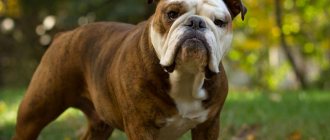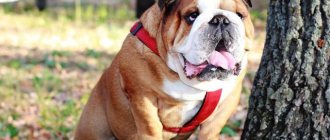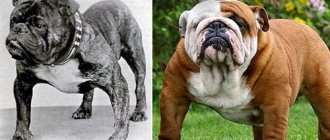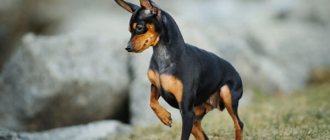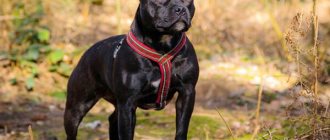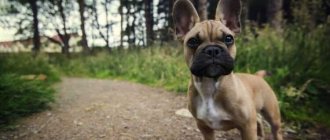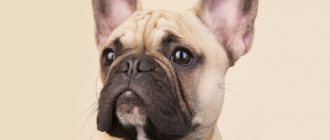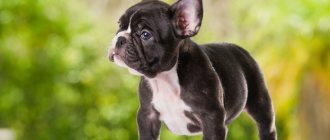| Origin: | Great Britain |
| Usage: | bodyguard, companion |
| Color: | red, fawn, white, combined |
| Dimensions: | height from 30 to 40 cm, weight 23-25 kg |
| Lifespan: | 10-12 years |
The English Bulldog is a breed of dog with a stern appearance, but a good-natured disposition. Among all types of bulldogs, it is second only to the French in popularity. They are ideal companion dogs and bodyguards who remain loyal to their owner. However, you need to find an approach to a pet - not every person will be able to raise a noble animal from it. We will discuss further what the features of appearance, character and content are, and how long bulldogs live.
History of the English Bulldog breed
English Bulldog
In the 17th-19th centuries, old English bulldogs descended from Central Asian mastiffs and North Caucasian Alans were common in Great Britain. They were in demand as baiting dogs for hunting. The name fully corresponded to its purpose: the word “bulldog” is translated from English as “bull dog”. It is the old English bulldogs that are the ancestors of the heroes of our article - modern English bulldogs.
There are significant similarities in appearance between the Old English Bulldog and the Modern English Bulldog. But the main difference is still the character. The ancestors of today's bulldogs were very vicious. They were used for crowd entertainment, pitted against bulls, horses and even bears and lions. Such bloody fights led to the death of not only wild animals, but also the bulldogs themselves, who became victims of fangs, horns and hooves. The end of such entertainment, so to speak, came in 1835, when the British government completely banned bullfighting. But this did not stop fans of the bloody “sport”: if it became impossible to pit Old English bulldogs against bulls, then instead of the latter they began to use other dogs.
After a short time, dog fighting was also banned. But such humanity played a cruel joke on the old English bulldogs. Deprived of the opportunity to participate in battles - be it with wild animals or with other dogs - the breed began to degrade, as its unusually powerful, strong jaws with a death grip were not used for themselves. Another blow for the breed was its actual extinction, since bulldogs were bred with representatives of other breeds, and ultimately there were very few purebred dogs left.
In 1858-1859, work began on the conservation of English bulldogs. However, the breeders set themselves another task - to eradicate excessive anger in them. It was not without difficulty that the most balanced individuals were selected throughout Britain. A year later, an exhibition was held in Birmingham, where samples of the “new” breed were presented. In terms of character and inner world, these were far from the same bulldogs that were known earlier. Visitors to the exhibition were able to fully appreciate the work of geneticists and breeders: the reviews were the most positive!
In 1873, the breed was officially recognized by the English Kennel Club, as evidenced by an entry in the stud books of that time. In the early 1880s, English bulldogs began to increasingly attract attention outside their historical homeland. And today no one will say why exactly they were loved: for their funny appearance or balanced character - most likely, for both.
Everything is not easy with the Olde English Bulldogge: an unrecognized breed and the main types of its representatives
Dog breeding does not tolerate anarchy. It lives and develops under the strict supervision of numerous cynological organizations (international and national), whose tasks, in particular, include standardization and recognition of newly created dog breeds.
Breed Old English Bulldog (newly created): a thorny path to recognition
It so happens that the Olde English Bulldogge breed is still not recognized by the FCI (Fédération Cynologique Internationale - the most authoritative canine organization in the world), UCI (Union Cynologique Internationale), KC (Canine Association of Great Britain) and AKC (American Canine Association). But she was recognized:
- ACA (American Canine Association Inc.);
- APRI (American Pet Registry, Inc.);
- BBC (Backwoods Bulldog Club);
- CKC (Continental Kennel Club);
- DRA (Dog Registry of America, Inc.);
- IOEBA (International Olde English Bulldogge Association);
- NKC (National Kennel Club);
- OEBKC (Olde English Bulldogge Kennel Club);
- OEBA (Olde English Bulldogge Association);
- UKC (United Kennel Club).
Among the listed organizations, the most significant in the canine world is the UKC (United Canine Union). The United Kennel Club has recognized the breed since 2014 and does not differentiate between the Old English Bulldog (newly created) and the Leavitt Bulldog.
Unfortunately, pedigrees and show titles issued by all these organizations are not recognized by the FCI.
“Old” “oldu” discord: main types Olde english bulldogge
Perhaps the lack of recognition from the FCI, KC, and AKC is partly due to the fact that the establishment of the Old English Bulldog breed (newly created) is not yet complete. Today, in Old Bulldog clubs (both American and European), there are three main lines of dog breeding:
- Victorian Bulldog, the largest and most similar in appearance to modern English Bulldogs;
- Renaissance Bulldog, drier and sportier;
- Continental Bulldog, which has the least number of folds on the head and muzzle and most fully complies with the FCI standard, which has recorded the manifestation of extremeness (for example, excess skin folds) as a defect.
Table: some comparative characteristics of the three main types of Old English Bulldogs
| Type | Height at withers, males (cm) | Height at withers, females (cm) | Weight, males (kg) | Weight, females (kg) |
| Victorian. | 46–50 | 44–48 | 29–45 | 25–38 |
| Renaissance. | 43–51 | 40–48 | 27–36 | 22–31 |
| Continental. | 42–46 | 40–44 | 25–30 | 21–27 |
So the appearance of Olde English Bulldogge representatives is diverse.
Photo gallery: representatives of three breeding lines of the Old English Bulldog (newly created)
"Old Victorian" is the largest representative of the Old English Bulldogs
“Old Renaissance” is distinguished by a somewhat “dry” physique and athleticism
"Old Continental" more accurately than other Old English Bulldogs meets some FCI standards
In this case, things are not going smoothly with the breed standard either.
Breed Features
Representatives of other breeds, for example, the American Akita or the Alaskan Malamute, are literally eager to be released. They love to walk and frolic. But this cannot be said about the English bulldog. This dog is a real homebody. His favorite place in the house is the master's sofa, around which he constantly spins and can sleep all day. Long walks, especially long distances, are also not his taste. Our “gentleman” is most comfortable close to home.
English bulldog puppies
Another feature of the breed is enviable stubbornness. If your English Bulldog doesn't want to do something, you will literally run out of steam trying to force him to do it. At some point, it begins to seem that your nerves simply won’t stand it, but you can’t really get angry with your pet, who is distinguished by very funny behavior. On the contrary, he will make you smile involuntarily even when you least want to.
An English Bulldog will become a true friend to younger family members. He establishes a strong connection with children and behaves simply wonderful towards them. Among the shortcomings, I would like to highlight the fact that dogs of this breed love to chew on various things, including the owner’s slippers. If you don’t give him a lot of chew toys, your pet will cause considerable damage to your property, ruining the legs of sofas, armchairs, and tables with his teeth.
Another characteristic feature of the breed is that natives of the British Isles do not tolerate heat well. For this reason, an English bulldog may not be the best choice for those living in hot areas. But he is perfect for living in the city, since he does not need constant physical exercise. True, many potential owners are confused by the dog’s inherent drooling and smell. This can really become a problem in city apartments, so before buying an English bulldog puppy, carefully consider whether you can get along with him, taking into account such characteristics of the animal.
Fun fact: English Bulldogs love to skateboard and are quite good at it! For example, in 2015, Otto the bulldog from Peru drove at high speed through 30 people who stood on the road and spread their legs.Mating
Only clinically healthy bulldogs are allowed to breed. According to the rules of the RKF, bitches are used for breeding after reaching 1.5 years. Professional breeders must attend the exhibition and receive an assessment, otherwise the mating will be invalidated.
To ensure that English Bulldog puppies are purebred, a purebred individual with all the necessary documents is chosen as a partner.
Favorable time for mating is 7-15 days of estrus. The owners carry out manual mating or artificial insemination. The latter method relieves the dog of unnecessary stress and physical activity.
Due to the peculiarities of the structure, only 10% of bitches give birth to puppies themselves - the rest require a caesarean section. You should undergo an examination in advance and agree with a veterinarian.
An English litter on average consists of 5-6 puppies.
Appearance of an English Bulldog
English bulldogs have a massive head and a small pelvis. Due to these structural features that do not allow puppies to pass through the birth canal normally, representatives of this breed often give birth with the help of a veterinarian who performs a cesarean section. In addition, the English Bulldog is a brachycephalic dog, the distinctive feature of which is a depressed nose and head.
These funny "Englishmen" are also distinguished by ungentlemanly behavior. Since they breathe with an open mouth, they swallow a lot of air, which, in fact, causes flatulence. Owners need to either just get used to it or keep an air freshener with them at all times.
general description
The English Bulldog is a medium-sized dog. He is smooth-haired, tightly knit and squat. The head is distinctly large, massive, its girth is equal to the height of the dog at the withers. A characteristic feature of bulldogs is a short and wide muzzle with an equally wide and large nose.
Height at the withers depends on gender. For males it is 36-41 cm, for females – 30-36 cm. Males have more weight, it is 20-25 kg. Bitches weigh 16-20 kg.
The English Bulldog combines not only the functions of a watchman, but also a bodyguard, a cheerful companion and a reliable friend. The dog's character is quite affectionate, but thanks to its menacing appearance, it can replace a guard dog: the bulldog scares away unexpected guests who covet other people's property.
Head
The head, when compared with the size of the dog as a whole, is quite large. But at the same time, it does not violate the overall symmetry, so the English bulldog does not look deformed, otherwise the quality of its movements would suffer. The muzzle is wide and blunt, and is distinguished by an upward curve.
The bulldog's forehead is flat, not too protruding or drooping above the muzzle. There are pronounced folds on the forehead and skin around the head. A groove is visible from the stop to the top of the skull - it is distinctly wide and deep.
The frontal bones are convex and prominent in projection. They are also distinguished by their height, width and square shape.
Teeth
The English Bulldog boasts a wide and massive square-shaped jaw system. The lower jaw, unlike the upper, protrudes forward and is curved upward. The jaw has six incisors located between the fangs in a straight line. The latter have a wide arrangement.
Representatives of the breed have large and powerful teeth, which, if the mouth is closed, are completely hidden in the mouth. When viewed from the front, you can see that the lower jaw is parallel to the upper jaw - it is located directly below it.
Eyes
Serious bulldog
The location of the eyes on the skull is low, at a decent distance from the ears. They are in line with the stop and are located at right angles to the furrow.
The eye placement is wide, but the outer corners are located inside the outer line of the cheeks. Their shape is round and their size is medium. They do not sink into the eye socket, but they are not convex either. The eye color is very dark, almost black. When viewed from the front, they do not detect any visible proteins.
Ears
The English Bulldog's ears are set high. When viewed from the front, each ear's front edge touches the upper corner of the skull, namely its outer line. Thus, the ears are placed as high as possible and far from the eyes.
The shape of the ears is the so-called rose: they hang and face back, that is, towards the back. The anterior or superior edge is characterized by a curvature both backward and outward. Thanks to this, the so-called back of the tongue is partially visible.
Nose and lips
These are the lips!
The nose of the English Bulldog is wide and large, it is deeply recessed between the eyes. The nasal fold does not affect the profile line. The color is black, there are no inclusions of brown, liver or red. The nostrils have similar characteristics. In addition, they are open, and a vertical groove is clearly visible between them.
The lips are wide and thick and at the same time very deep and drooping. Thanks to the latter quality, they completely close the jaw from the sides. But this does not happen in front: here the lips only cover the teeth.
Neck
The English Bulldog has a neck of medium length, strong, robust and very thick. It has a slightly convex shape. There is thick, loose and folded skin around the throat, forming a double chin (dewlap) that extends from the lower jaw to the chest.
The breed standard requires that the length of the neck be in harmony with the size of the dog's head and body. If the neck is short, this may indicate that the animal has respiratory problems, not to mention the fact that insufficient length does not have the best effect on the general appearance of the English Bulldog.
English bulldog muzzle
Frame
The topline, when viewed just behind the withers, is slightly lowered at the very bottom. Then it rises to the lower back, becoming a level higher than the height of the dog at the withers, and, rounding, decreases towards the tail. Thanks to such “intricacies” of the topline, a sail arch is formed, which is one of the calling cards of the breed.
Our “gentleman’s” back is short and distinguished by his power. The English Bulldog is broad in the shoulders. Relatively narrow back only in the lower back.
The chest of representatives of this breed is wide and deep, from the withers and directly to the very bottom, and also convex and rounded on the sides.
The dog's belly is toned and does not sag.
Tail
You take a walk yourself, and I’d rather sit here
The tail is set low, quite straight and thick at the base, and then curves down and tapers towards the end. The shape is round, the skin on the tail is smooth, there is no coarse hair, and there is no fringe. If we talk about the length, it is rather short. It never rises above the back.
Limbs
The English Bulldog has large, strong and robust forelimbs. They are thick, with well-developed muscles, and have a wide stance.
The outer line of the limbs looks noticeably curved, but their bones are straight: no curvature or bending is observed in them. They are short in comparison to the hind legs, but not so short that they make the dog's back appear longer than they actually are, or that they interfere with your pet's daily activities.
The shoulders are wide, they are distinguished by power, they have developed muscles. But they can also be described as deep, sloping and sloping. The elbows are low and spaced from the ribs. The pasterns can be described very succinctly: powerful, straight and short.
The hind limbs of bulldogs are also large and muscular. Since they are longer than the front ones, this results in the effect of raising the dog’s lower back. The lower part of the hind legs has the following characteristics: it is straight, short and powerful. Round knees are characterized by a slight turn away from the dog's body. The hock joints are low and slightly curved, with moderate angulation.
Both the front and hind legs have the outward turn characteristic of the breed. The only difference between them is that the first are medium in size, straight and moderately rounded, while the second are compact, round in shape. The toes of the hind legs are arched and thick, as a result of which their joints are raised and, accordingly, protrude high.
The English Bulldog is distinguished by a peculiar, one might even say, gait that is not quite usual for dogs. He moves with short, quick strides on his fingertips. At the same time, the hind legs do not rise high, so our “gentleman” shuffles slightly. The breed standard suggests that quality and confidence of movement are of great importance.
Wool
Short, with a delicate texture. It is smooth and fits tightly. Shouldn't be wavy.
Color
It is distinguished by uniformity, purity and brightness. There are different colors in the English Bulldog breed, but preference should be given to red brindle and all other brindle colors, white, red, fawn, piebald - and in that order.
English bulldog white color
If you choose from a good piebald, a dirty piebald or a dirty solid, then a good piebald is preferable.
Black color is considered vicious and is allowed only in piebald color in the form of spots in moderate quantities. To prevent a spotted color from being perceived as defective, the colors should be evenly distributed in small spots.
If your pet has a small white spot on his chest, this is acceptable, but only in two color options: solid and brindle.
Possible defects
Any deviation from the listed standards of head, teeth, eyes, ears, neck, body and limbs should be considered as faults or faults of the breed.
The degree and depth of these deviations are judged depending on their impact on the health and daily functioning of the dog.
Disqualifying faults
If an English Bulldog shows aggressiveness or excessive timidity, if it has noticeable respiratory distress or an ingrown tail, then such defects are considered disqualifying.
Any dog exhibiting abnormal behavior or mental abnormalities must be disqualified.
Please note: male dogs must have two normally developed testes, fully descended into the scrotum.
Disqualifying faults
The main defects of the breed include:
- drooping ears;
- sprouted tail or its complete absence;
- deafness, often found in white dogs;
- labored breathing;
- fluffy wool;
- overweight or underweight;
- non-fixed hock joints.
Cowardly or overly aggressive behavior or excessive nervousness in a French Bulldog can also be a serious disqualifying sign.
Return to content
Photo of an English bulldog
Character Olde English Bulldogge
Although the breed standard defines the Olde as an outgoing, friendly and happy dog, let's face it: the Old English Bulldog does not have the easiest temperament. This dog:
- stubborn, like all bulldogs;
- characterized by an exaggerated sense of self-esteem;
- prone to dominance;
- initially has a very rough idea of the discipline.
Therefore, when raising a puppy, its early socialization and persistent training in order and obedience are necessary. At the same time, any punitive physical impact on a bulldog child is absolutely unacceptable: this way you risk making an enemy. You will need:
- limitless patience;
- perseverance;
- experience in training (your own or a good dog handler from outside);
- the ability to secure and maintain a leadership position.
When training an Old English Bulldog puppy, the owner will need considerable patience and perseverance.
But if you manage to explain to this gentleman who is boss in the house, you will get a wonderful friend and protector:
- courageous;
- decisive;
- friendly;
- patient and affectionate with all family members and other pets;
- reliable;
- devotee.
A properly socialized “old” gets along well with children, but his relationship with a small child must be controlled: an energetic and fairly heavy dog can “drop” the baby during play, simply by accidentally pushing him.
Bulldog stubbornness is something. I adored my dog, he responded in kind, unconditionally recognizing me as the leader of the pack and obeying almost strictly. Almost yes. Not counting those moments when I was alone in the house. The dog didn’t like this and stubbornly demonstrated his dislike, every time he was alone, lightly peeing on the piano leg. No explanatory work, no strict suggestions and prohibitions (absolutely understood, but not accepted) had any effect until his death. Bulldogs - they are such bulldogs...
Character of the English Bulldog
The English Bulldog perceives the family in which it lives as its “pack”. The pet empathizes with everything that happens in the house, showing sensitivity and devotion towards its owners.
With beloved owner
A representative of this breed will be a good companion. He loves children very much, realizing that they are the object of the universal love of adults, and tries to imitate the latter in this, showing similar feelings to small family members. By nature, our “Englishman” is somewhat simple-minded, which makes him an indispensable participant in children's entertainment. Bulldogs are noisy, playful, very energetic and at the same time impatient.
Important: an English bulldog should be weaned from childhood on the habit of jumping on people in the house. Otherwise, when he grows up and becomes heavy enough, he may suddenly jump on the owner or one of the family members, and at the most unexpected moment. If an adult dog jumps on a child, it can injure him.
English bulldog with children (and apple)
Despite the simplicity, the dog of this breed is very smart. In addition, she does not tolerate loneliness well. With a lack of communication, she becomes gloomy and obstinate. By the way, stubbornness is one of the characteristic character traits of the bulldog, thanks to which he gained worldwide fame. It is impossible to force an English bulldog to do anything using rudeness or force, but it is quite possible to come to an agreement with him, as they say, in an amicable way. Dog breeders respect this quality of representatives of this breed so much that the bulldog has become the mascot of many sports clubs.
What else impresses about the English Bulldog is its deep devotion to man. He accepts his owner as anyone - energetic or lazy, joyful or sad, successful or not, that is, as he is, and is always ready to protect his owner if he is in any danger.
The English Bulldog has a menacing appearance, but at heart he is affectionate, friendly and calm. At the same time, he is distinguished by independence and independence, balance and self-confidence. In relation to other domestic animals, the “Englishman” behaves peacefully.
English bulldog met a kitten
Interesting Facts
The English Bulldog is a dog with an unusual and unpredictable character.
There are many interesting stories about the English Bulldog, here are some of them:
- The British are the cartoon characters Sturdy from PAW Patrol and Spike from Tom and Jerry. These dogs also appear in the films “Hotel for Dogs”, “The Adventures of Sherlock Holmes and Dr. Watson” and others.
- In Daugavpils, Latvia, there is a monument to the former mayor and his bulldog.
- Winston Churchill was often compared due to some qualities and external similarities with dogs of this breed; you can even find the nickname Churchill. But the prime minister's favorite breed was poodles. He himself spoke of this dog as beauty brought to the point of absurdity.
- The ancestors of modern Englishmen are considered to be the couple Rose and Criba; their names were included in the stud book in 1817.
Training and education
It is difficult to classify the English Bulldog as a breed whose representatives can lay claim to the title of beauty champions. However, they also need training, even minimal.
The English Bulldog is a true gentleman
A strong-willed person with a strong and patient character must teach a dog “rules of decency” and train it. Only having such qualities can you cope with this breed, since it can show disobedience and basic laziness.
You should start training by teaching your English Bulldog to use a leash. It shouldn't be too long or too short. Many people think that if the leash is short, it will help hold the dog more securely. However, this is a misconception, since in this case the dog, on the contrary, will begin to break free.
Having put a collar with a leash of optimal length (2-2.5 m) on the bulldog, start moving forward, giving the dog the command “Near!” At the same time, make sure that she walks next to the left side, without running ahead or falling behind. When you are sure that your pet has learned to walk well in a straight line, start learning turns in different directions, as well as a full turn.
It is important to teach your English Bulldog to sit when you stop. To do this, command him to “Sit!” The command should be accompanied by the following action: place your left hand on his croup and press lightly. A few lessons will be enough for the dog to understand: every time the owner stops, he must sit down, even if he does not say the command. And even more so, she must learn that she needs to sit down every time the command “Sit!” pronounced.
Walking with English Bulldogs
Learning ability
It is not easy to train an English Bulldog - he does not follow commands if he does not consider them necessary. Therefore, the educational process must begin with the appearance of a puppy in the house and require him to obey the rules.
It is important to teach your puppy not to take food from the wrong hands, not to bite during play, and not to sleep on beds. Later, you can teach him a general training course - the commands “come to me”, “next to me”, “sit” and others. When training a pet, you need to be in constant contact with it, praising it at the moment of correct actions. The dog will quickly understand that the owner is happy when he is obedient, and will strive to please.
English bulldog: description of the breed, character, how long they live
Care and maintenance
Due to the fact that the English Bulldog has a smooth, short coat, it is much easier to care for than representatives of a number of other breeds. You will need a brush with stiff bristles, which is recommended to be used to brush your pet two to three times a week, which will give your bulldog a lot of pleasure.
Super bulldog will save this city!
Particular attention should be paid to the folds on the muzzle. Their proper condition in terms of hygiene is the key to the dog’s health. If dirt accumulates in the folds, remove it with a damp cotton pad. To dry the fold, wipe it with dry cotton wool. No cosmetic products are required to care for an English Bulldog, as their use can cause allergies. Allergic reactions are also possible if the fold on the muzzle is left undried.
You should not bathe your English Bulldog too often - it is enough to do this in cases of urgent need. Frequent bathing procedures can cause peeling of the skin, which will be accompanied by constant itching and cause considerable discomfort to the dog. After walks, it is best to remove dust from the coat with a damp cloth.
It is important to control the growth of claws; they should be trimmed regularly. It is recommended to brush your English Bulldog's teeth regularly, at least once a month. Otherwise, tartar will immediately begin to form.
In the fresh air, bulldogs are very active and during walks they are not averse to playing sports with their owner. If you neglect physical activity, the English Bulldog will begin to gain excess weight, which will subsequently turn into obesity. However, do not be too active with your pet on hot or cold days. Due to the fact that the dog has short hair, it can freeze in cold weather, and get heatstroke in hot weather.
Please note: if you purchased a 2-3 week old puppy in the summer, be sure to place a container with ice cubes in the box with it. As soon as you notice the first symptoms of overheating, be sure to clear the bulldog's throat of accumulated secretions, rinse it and immediately contact a veterinarian.
In general, the English Bulldog, compared to some other breeds, is not a very active dog. It does not need large spaces. Living in an apartment or in a country house, he dozes most of the day, and this also leads to an increase in body weight.
When it comes to nutrition, English Bulldog owners have 2 options: natural food or dry food. It’s better to decide right away – a mixed diet is not recommended for this breed. Most dog breeders prefer industrial super-premium or holistic food. This nutritional system will be convenient when traveling, and you won’t have to monitor the balance of your diet.
In the case of natural feeding, it is important to maintain a balance. Because bulldogs are prone to obesity, their menu should consist primarily of protein foods with limited carbohydrates. However, they cannot be completely excluded, otherwise the dog may develop urolithiasis. An example of an “Englishman’s” food basket: veal, beef, rice, buckwheat, eggs, kefir, cottage cheese, fresh herbs, vegetables, some fruits and berries. A puppy should eat 59 g of meat per 1 kg of weight, and an adult English Bulldog should eat 250 g of meat daily.
Found nothing...
English bulldog puppy sleeping next to his mother
Dog food
The English Bulldog's diet must be balanced and properly selected. This is a prerequisite for the growth and development of a pet. They have a high tendency to become obese, so they need to balance their diet.
What to feed an English Bulldog? You need to feed your dog with special and high-quality dry food, premium class or natural food. Don't forget about vitamins, supplements and minerals. The dog should receive all the food it needs: meat, fish, cereals, dairy products, some vegetables and fruits, eggs.
Feedings should be frequent and not in large portions.
English Bulldog Health and Diseases
The English Bulldog breed is characterized by diseases such as cherry eye, keratoconjunctivitis, interdigital dermatitis, skin fold dermatitis, entropion, acne, congenital dislocation of the elbow, demodicosis, heat stroke, hypothyroidism, distichiasis, tracheal hypoplasia, cryptorchidism, aortic stenosis, brachycephalic syndrome, vaginal hyperplasia, tetralogy of Fallot, deafness, difficult childbirth, lymphosarcoma, ventricular septal defect.
Before choosing an English Bulldog, a potential owner should take into account that representatives of this breed are prone to digestive problems. They are also prone to flatulence, may snore and drool profusely.
Behavior, temperament
French bulldogs are easy-going, sociable and kind dogs. They learn basic commands very well. They get along quite well with other pets if they are properly raised from an early age.
Until 5-6 years of age, these are very active and curious creatures; in maturity they become calmer and quieter.
Return to content
How to choose a puppy
Am I really cute?
You should ask the breeder in more detail about each of the puppies that he offers you. It is absolutely not necessary to buy the first one who runs up to you: as you grow older, he may not suit your character. The final choice should be made after you learn from the seller about the behavioral characteristics of each puppy, and after observing them for some time. Pay attention to the puppy's body. It is desirable that the format of a small bulldog be square, with a raised croup.
In advance, you must decide the question of who exactly you want - a male or a female. In any breed, the difference between the sexes is significant, and English bulldogs are no exception. The brightest representative of the breed, of course, is the “man,” that is, the male. In terms of his external qualities, he is more interesting and impressive than the representatives of the “weaker sex”. He's bigger, wider, and stronger. She carries herself proudly and importantly, has a more flexible character and, unlike female dogs, does not show empty fussiness.
Be sure to ask the breeder what the puppies were fed. If, for example, dry food, then for the first time take some food from where you bought your pet. Also take with you a small cloth that retains the scent of the place where the puppy was born and its brothers and sisters. In this case, the puppy will tolerate both a change in diet and a change of environment much easier.
And, of course, before purchasing, be sure to carefully study the official standard of the English Bulldog. Preferably with detailed comments on its shortcomings and defects for each item. This is especially important if you are choosing not only a friend, as they say, for the soul, but also a future participant in exhibition competitions.
The potential owner of this dog should also take into account the fact that many breeders bred this breed without taking into account the peculiarities of its character, and this led to an increase in the number of individuals with aggression in character. Therefore, do not let your pet grow up on its own, take care of it, educate it. Only in this case will you get an excellent friend with a healthy psyche, loyal and reliable.
How to glue ears?
The current breed standard allows only one type of ear shape - the so-called “rosette”. For many puppies, as they grow older, their ears themselves take on the desired shape. However, not everyone is lucky - some puppies are in no hurry to “fold” and remain hanging, which is unacceptable for a show dog. In such a situation, owners resort to a specific procedure known as “gluing” the ears.
It should be noted that this procedure is purely cosmetic - it does not improve any characteristics and is not required for ordinary, non-show dogs. Gluing is necessary only for owners of exhibition and future breeding animals.
Ear shaping is done when puppies reach three to four months of age. For this you will need:
- adhesive plaster in a roll on a cotton basis;
- scissors;
- glue "Moment".
The process diagram looks like this:
- the hair along the outer edge of the ear is cut (it is cut, not shaved, since otherwise irritation may appear on the skin);
- a piece of adhesive tape is cut along the length of the ear;
- the edge of the ear is glued with adhesive tape, the excess is carefully trimmed with scissors;
- the outer side of the patch is smeared with Moment glue;
- Next, the puppy’s ear must be pulled up, carefully bent in the right place and folded in the shape of a “rose”;
- press the edges of the ear with your fingers and hold for at least 10 minutes;
- For the first half hour after gluing, you should not allow the puppy to shake its head or scratch its ears.
The puppy quickly gets used to the glued ears, and within half an hour after the procedure he can no longer be controlled.
The adhesive is kept for 1 to 4 weeks, regularly checking the condition of the ears.
In recent years, special glue has appeared in veterinary stores to seal the ears of dogs. This glue is non-toxic, absolutely harmless and guarantees reliable fixation of the desired ear shape. It dries in just three minutes, there is no need to cut six on the dog's ear, and you can remove the glue after fixing the shape using baby oil or a simple comb with thick teeth.
Photos of English Bulldog puppies
How much does an English bulldog cost?
An English bulldog can be bought in Russia with or without documents.
If you have chosen a puppy without documents, then the purchase will not be too burdensome for the family budget: you will pay between 2500-5000 rubles. But in this case, you should be prepared for the fact that you are buying a “pig in a poke.” In the sense that no one guarantees you the purity of the breed. When buying a registered puppy from a breeder, be prepared to spend a lot of money. An English bulldog with an “identity card” costs about 23,000 - 35,000 rubles.
A descendant of titled parents and a future champion of various exhibitions will cost about 40,000 - 70,000 rubles.
Application
For several centuries, bulldogs were used to bait bulls. Now the dog has settled down and turned into a good-natured, but extremely emotional and affectionate companion, like a Boston Terrier .
However, this good nature should not be tested. There is genetic memory, and the dog can rush to protect the owner.
Agree, it is difficult to restrain a large dog weighing a quarter of a hundredweight that rushes forward with pressure.
Bulldogs can be taught the necessary commands, but they perform them, as if reluctantly, doing a favor, thinking about each of them
